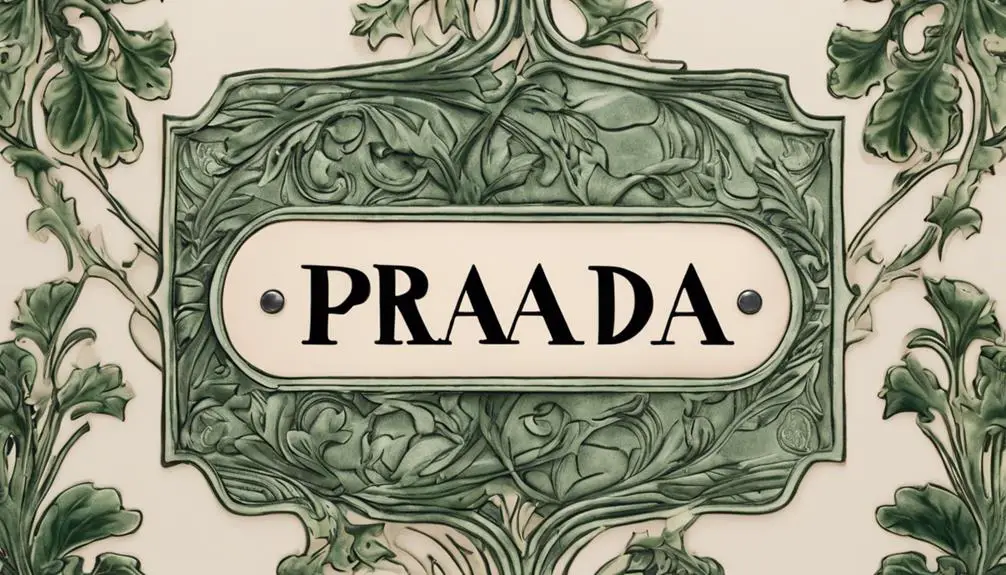"Prada" means "meadow," a term rooted in an area once tied to agriculture and community heritage. This name, originating from Prada de Conflent in southern France, reflects a rich history associated with landowners and farming. Founded in 1913 by Mario Prada in Milan, the brand has transformed from a simple word into a symbol of luxury and sophistication. Today, it stands for modern elegance and innovation, impacting fashion on a global scale. Curiously, "Prada" also conveys meanings of generosity in different cultures, highlighting its deeper significance. Stick around, and you'll uncover even more fascinating insights!
Etymology of Prada

The name "Prada" has fascinating origins that trace back to Italy, specifically linked to the region of Prada de Conflent in southern France. Etymologically, "Prada" translates to "meadow," which reflects the area's historical ties to agriculture and land ownership.
When you think about the word "meadow," it conjures images of lush greenery and blooming flowers, symbolizing fertility and growth. This natural beauty is deeply embedded in the identity of the region, long before the name became synonymous with a luxury fashion brand.
As you explore deeper into the etymology of "Prada," you'll discover variations like Radar, Bradan, and Pradip. These names showcase the rich tapestry of regional linguistic influences and their unique cultural significance.
Historically, the name was associated with landowners and farmers, contributing to a sense of community and heritage in the area. It's intriguing to realize that this simple word carries the weight of agricultural tradition and the pride of local identity.
When you wear Prada today, you're not just sporting a luxury fashion brand; you're connecting with a rich history that dates back centuries. The transformation from a name rooted in meadows to a global symbol of fashion excellence illustrates how meanings can evolve.
Cultural Significance of Prada
Prada stands as a powerful symbol of luxury and sophistication in the fashion world, influencing trends and setting standards since its founding in 1913. As a luxury fashion house, Prada represents more than just high-end clothing and accessories; it embodies modern elegance and innovation while honoring traditional craftsmanship. This unique blend reflects Italy's rich cultural heritage, making Prada a beacon of artistic expression that resonates globally.
The brand's iconic minimalist aesthetic and refined craftsmanship further solidify its esteemed position in the luxury market, as seen in its vintage tag identification practices that emphasize authenticity.
You might notice Prada's influence extends beyond runways and fashion magazines. The brand often collaborates with artists and designers, intertwining various cultural narratives and pushing the boundaries of creativity. This commitment to artistic innovation helps shape contemporary culture, positioning Prada as a pivotal player in the fashion industry.
Moreover, Prada's presence in popular culture, from films to music, has solidified its status as a cultural icon. When you see a character wearing Prada, it conveys a message of luxury and style, influencing how people perceive fashion.
But Prada doesn't stop at aesthetics; its dedication to philanthropy and social causes enhances its cultural significance. By engaging with community issues and promoting responsible practices, Prada champions a more sustainable fashion industry.
In essence, Prada isn't just a luxury fashion house; it's a cultural force that inspires, innovates, and influences. Understanding its cultural significance allows you to appreciate the brand not just for its products, but for its role in shaping modern society's view of luxury and style.
Historical Context of Prada

Originating from the picturesque region of Prada de Conflent in southern France, the name carries historical significance that extends far beyond its modern luxury connotations. The roots of Prada reflect a rich agricultural heritage, where landowners and farmers shaped the cultural identity of the area.
As you explore the historical context of Prada, consider these key points:
- Agricultural Origins: The name symbolizes fertility and growth, deeply connected to the meadows that flourished in the region.
- Cultural Impact: Prada was historically associated with landowners, contributing to the community's economic and social structures.
- Transition to Fashion: Founded in 1913 by Mario Prada in Milan, the brand evolved from its geographic origins into a global luxury fashion icon.
The transformation of Prada from a regional name to a powerhouse in the fashion industry showcases its historical significance. Influential families and fashion innovators helped elevate the brand, allowing it to transcend its rural roots.
As the brand gained recognition, it became synonymous with elegance and sophistication, drawing on its heritage while adapting to modern styles.
The journey of Prada illustrates how a name can evolve, reflecting not just its past but also its impact on contemporary fashion. By understanding its history, you can appreciate the depth and meaning behind the luxurious products that bear the name today.
Modern Interpretations of Prada
Since its inception, Prada has redefined what luxury means in the fashion world. Founded in 1913, the brand stands out for its high-end craftsmanship and innovative designs, making it synonymous with luxury fashion today.
You'll notice that Prada isn't just about clothing; it's a lifestyle brand that includes luxury accessories, eyewear, and fragrances. This expansion has helped the brand maintain a significant presence across various markets through smart licensing agreements.
One of Prada's defining characteristics is its minimalistic aesthetic. It combines contemporary style with traditional Italian craftsmanship, influencing global fashion trends. When you wear or carry Prada, you're not just showcasing fashion; you're embracing an image of exclusivity and elegance that appeals to affluent demographics.
It's no wonder that the brand has made a notable cultural impact, even appearing in popular media like the film "The Devil Wears Prada." This portrayal has solidified its status in contemporary culture and helped people understand the essence of luxury associated with the brand.
In modern contexts, Prada continues to inspire and push boundaries, making it a hallmark of luxury. Whether you're eyeing a sleek handbag or a pair of stylish sunglasses, you can feel the brand's commitment to quality and design.
Simply put, Prada isn't just a name; it's a symbol of modern luxury that resonates with fashion enthusiasts around the world.
Prada in Language and Philosophy

In exploring the significance of "Prada" in language and philosophy, you'll find that it transcends mere branding to embody deeper cultural meanings. The term "Prada" reflects various forms of giving, rooted in traditions that emphasize generosity and moral obligations.
Here are three key insights about "Prada" in this realm:
- Cultural Roots: In Sanskrit, "Pradā" means "gift" or "offering." This highlights the importance of giving in Hindu and Jain cultures, showing how acts of generosity are woven into the fabric of society.
- Language Nuances: In Marathi, "Prada" signifies the act of giving, showcasing the diversity in how different cultures interpret generosity. This linguistic variation enriches our understanding of the ethical implications behind giving.
- Philosophical Concepts: The philosophy surrounding "Prada" emphasizes reciprocity and dharma, or moral duty. When you give, you engage in a broader conversation about community welfare and the responsibilities that come with generosity.
The cultural significance of "Prada" also extends to rituals, symbolizing blessings and divine favor in Hinduism and Jainism.
This deeper meaning reminds us that the intention behind giving is just as important as the act itself. Through these various interpretations, you can see how "Prada" serves as a bridge connecting language, philosophy, and cultural practices, enriching our understanding of generosity across different domains.



